Yoga Garden Ideas: Creating a Space for Mindful Living
Step barefoot into your garden where every detail invites stillness. Sunlight filters through leaves, creating dancing shadows on the ground. The air feels heavy with lavender. Somewhere nearby, water trickles over stones.
This is your yoga garden—more than just a place to stretch. It’s a sanctuary designed for balance, mindfulness, and deep connection to nature. Unlike indoor studios with their artificial lights and recycled air, a yoga garden breathes with you.
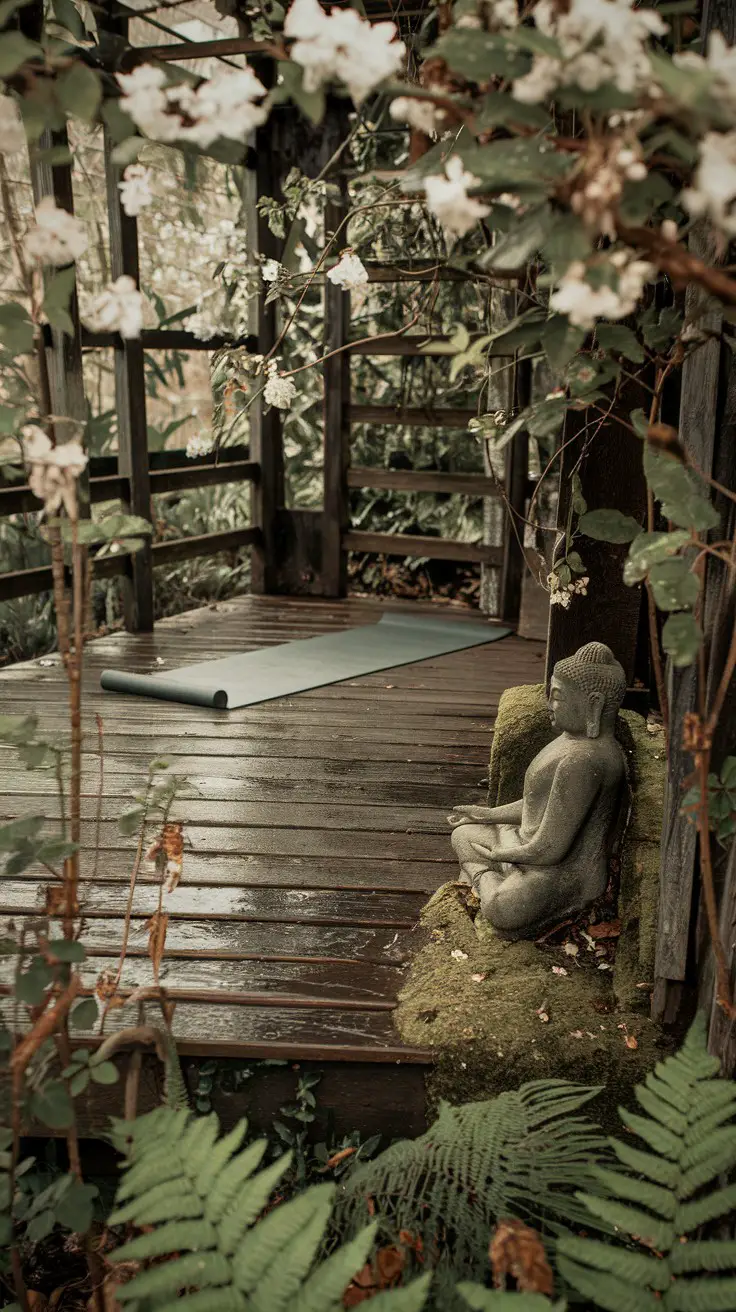
Whether you have sprawling acres or just a forgotten corner behind the shed, this article delivers practical yoga garden ideas for every space. We’ll explore design elements that transform ordinary backyards into mindful retreats. From simple aesthetic touches to full backyard studio conversions, you’ll find inspiration that fits your life.
No perfect lawns required. No massive budgets needed. Just real ideas for real gardens.
Why Create a Yoga Garden?
Mind-Body Connection Outdoors
Practicing yoga outside changes everything. Your breath syncs with the wind. Birds become your soundtrack. The earth grounds you through every pose.
Indoor studios can’t replicate this. Four walls limit your awareness. But in a yoga garden space, your practice expands beyond the mat. You feel connected to something larger.
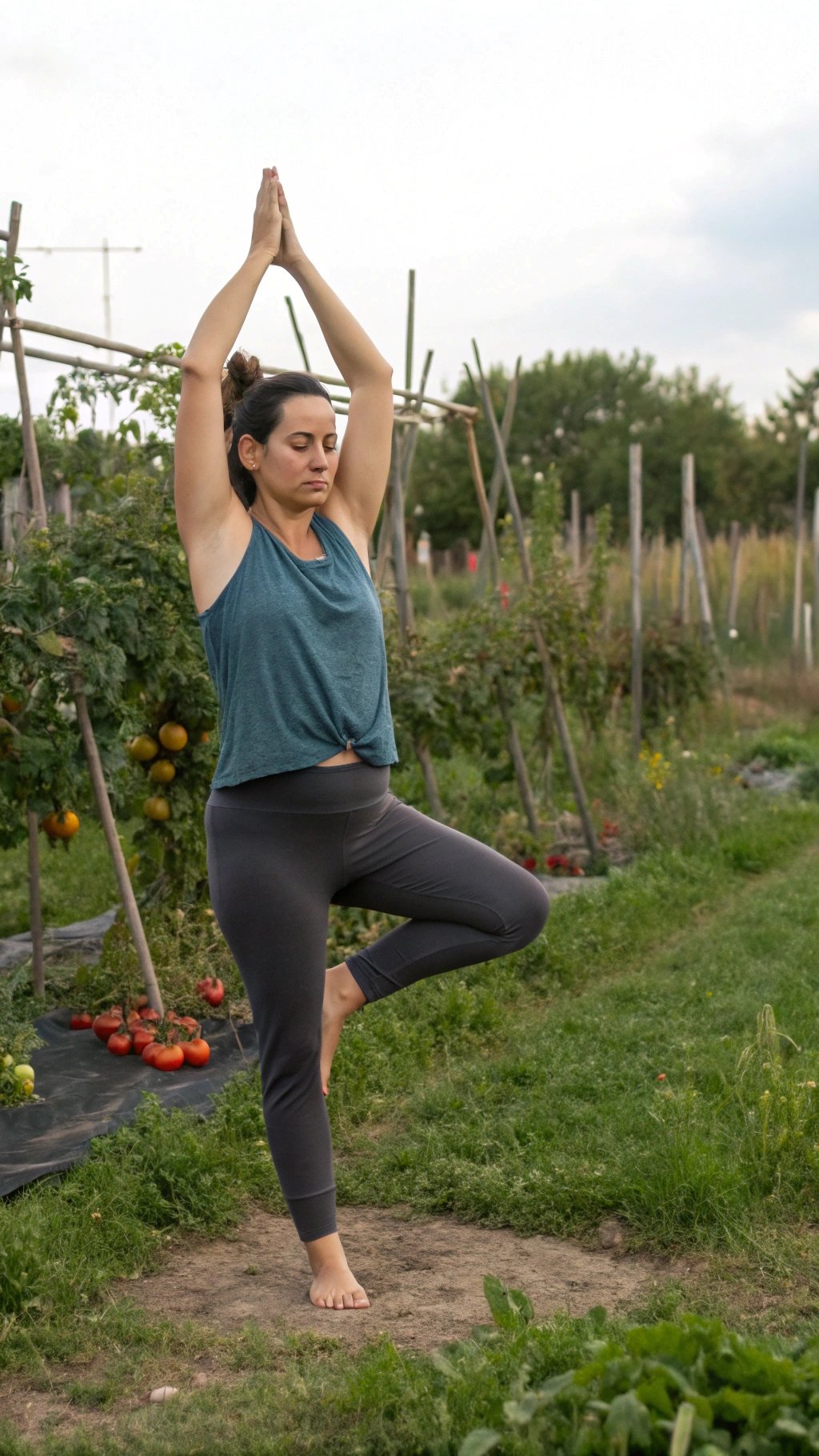
Mental Benefits
Gardens naturally calm the mind. Add intentional yoga garden area design, and you create powerful spaces for meditation and stress relief.
Science backs this up. Studies show that outdoor exercise reduces cortisol levels faster than indoor workouts. Green spaces lower blood pressure. Natural sounds improve focus.
But you don’t need studies to know this truth. Just spend five minutes breathing in your garden. Feel the difference.
Physical Flow and Fresh Air
Fresh air transforms your practice. Deeper breathing happens naturally outdoors. Your lungs expand fully. Oxygen flows freely.
Indoor air gets stale. Windows help, but they’re not enough. In a yoga garden space backyard, every inhale brings life.
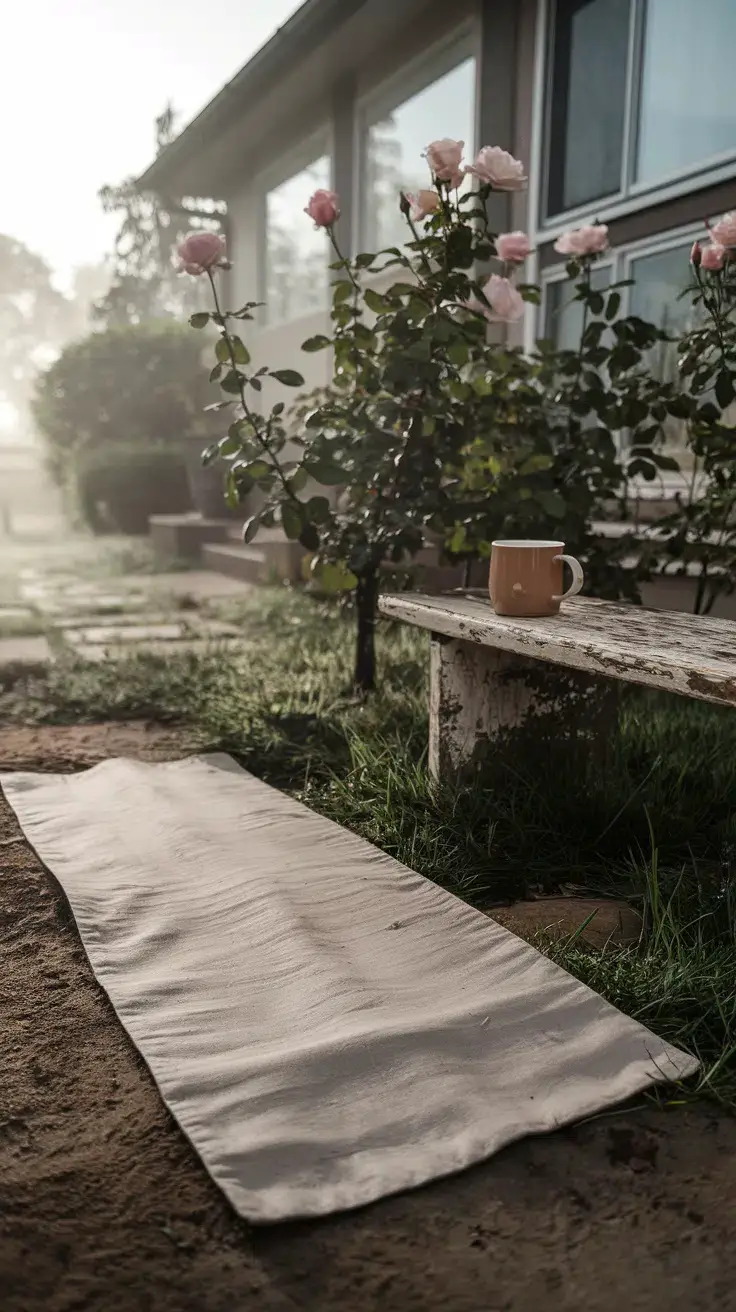
Indoor Studios vs. Outdoor Gardens
Many yogis start indoors. Studios offer community, guidance, consistent temperatures. But something shifts when you move outside.
The yoga garden aesthetic can’t be manufactured. No amount of plants in pots or nature sounds through speakers matches the real thing. Wind becomes your teacher. Uneven ground challenges your balance. Insects remind you to stay present.
Some days rain threatens. Birds get loud during meditation. The neighbor’s dog barks. And that’s exactly the point. Real life happens in gardens. Your practice learns to flow with it, not despite it.
Planning Your Yoga Garden Space
Assessing Your Space
Look at your yard with fresh eyes. Forget what it lacks. See what it offers.
That shady corner by the fence? Perfect for hot summer sessions. The flat spot near the compost bin? Ideal for morning sun salutations. Even tiny spaces work—a 6×6 foot area gives you room to move.
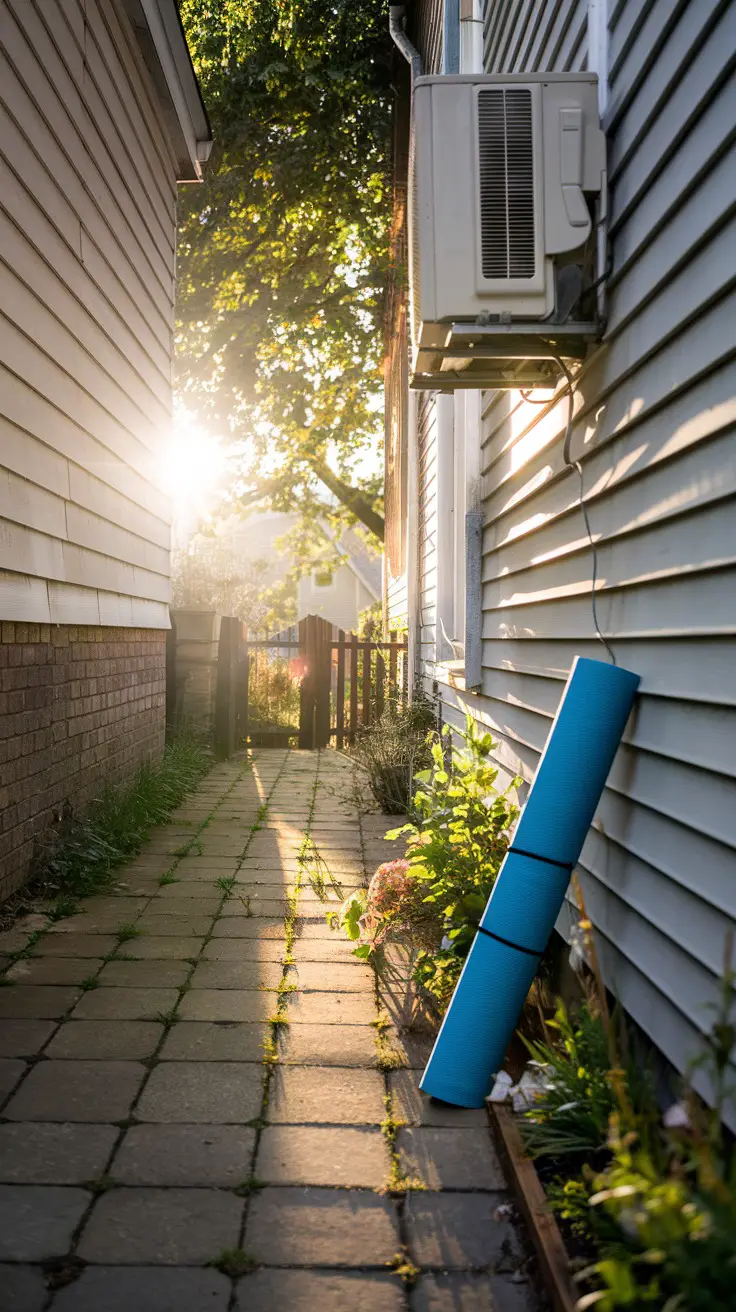
Check these factors:
- Light: Where does sun hit at your practice time?
- Privacy: Can you move freely without feeling watched?
- Noise: Are there quiet pockets away from traffic?
- Ground: Is it level enough for balance poses?
Small Spaces vs. Large Gardens
Big gardens offer options. Small ones demand creativity. Both work beautifully.
Large spaces let you zone different areas. Maybe a yoga corner in the garden for quick morning stretches. A meditation spot under trees. An open lawn for group sessions.
But small spaces focus your energy. One perfect corner becomes sacred. You know every plant, every stone. The intimacy deepens your practice.

Budget Considerations
Start simple. A mat on grass costs nothing. Add elements slowly as your practice grows.
Free or cheap options:
- Clear existing space
- Use natural shade from trees
- Repurpose old blankets as meditation cushions
- Collect smooth stones for borders
- Grow cuttings from friends’ gardens
Mid-range investments:
- Wooden deck tiles ($50-200)
- Simple shade sail ($30-100)
- Basic water feature ($50-150)
- Outdoor cushions ($20-80)
- Solar string lights ($15-40)
Splurge options:
- Custom yoga garden studios ($5,000+)
- Professional landscaping ($2,000+)
- Built-in water features ($500+)
- Permanent structures ($1,000+)
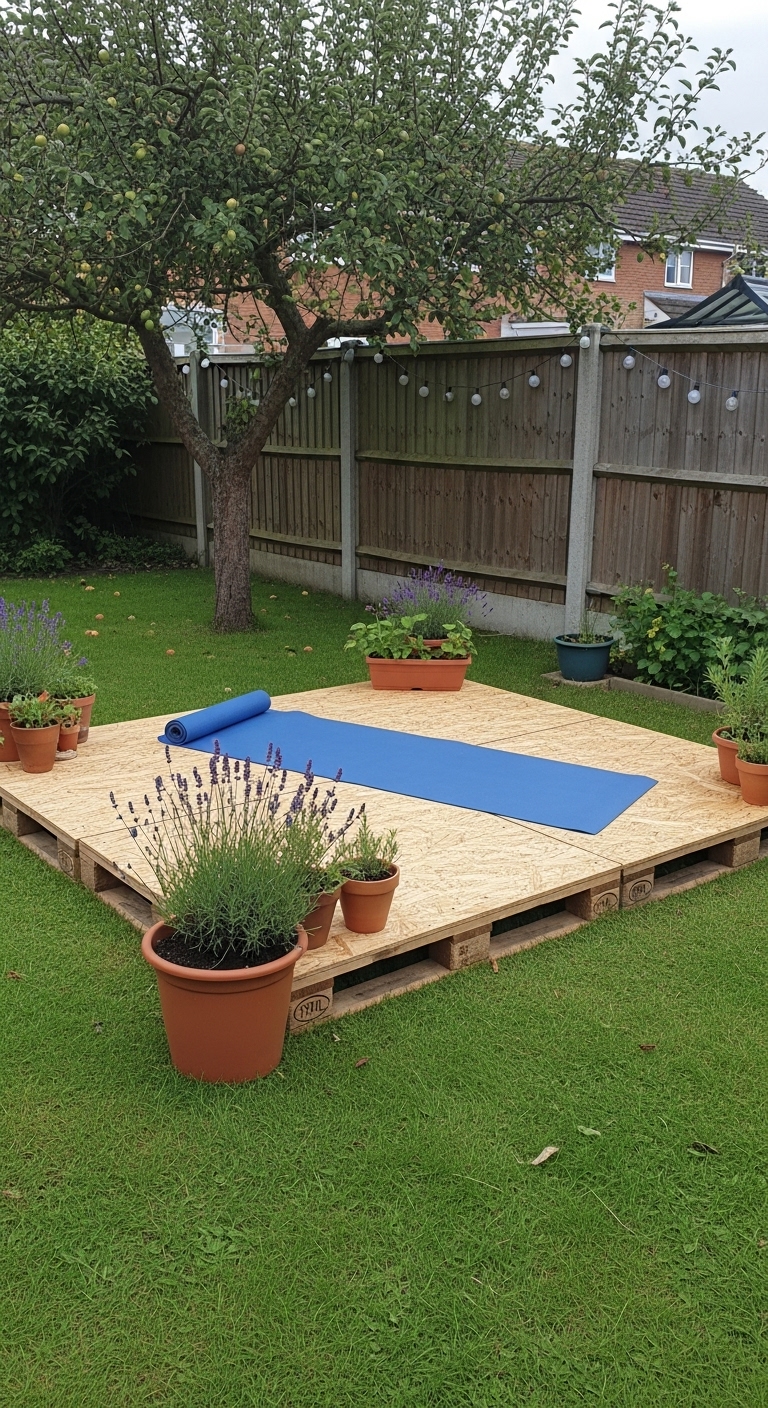
Backyard Zoning Tips
Integrate your yoga garden area naturally. Don’t fight existing landscaping—work with it.
Use what you have:
- Existing trees become natural screens
- Garden beds create boundaries
- Pathways guide movement between zones
- Current seating areas double as meditation spots
Define spaces without walls:
- Different ground materials (grass to gravel)
- Height changes (raised beds, sunken areas)
- Plant groupings
- Decorative elements
Remember—your yoga garden design should flow with daily life. Kids still need play space. Dogs need running room. Gardens need tending. Find harmony between all uses.
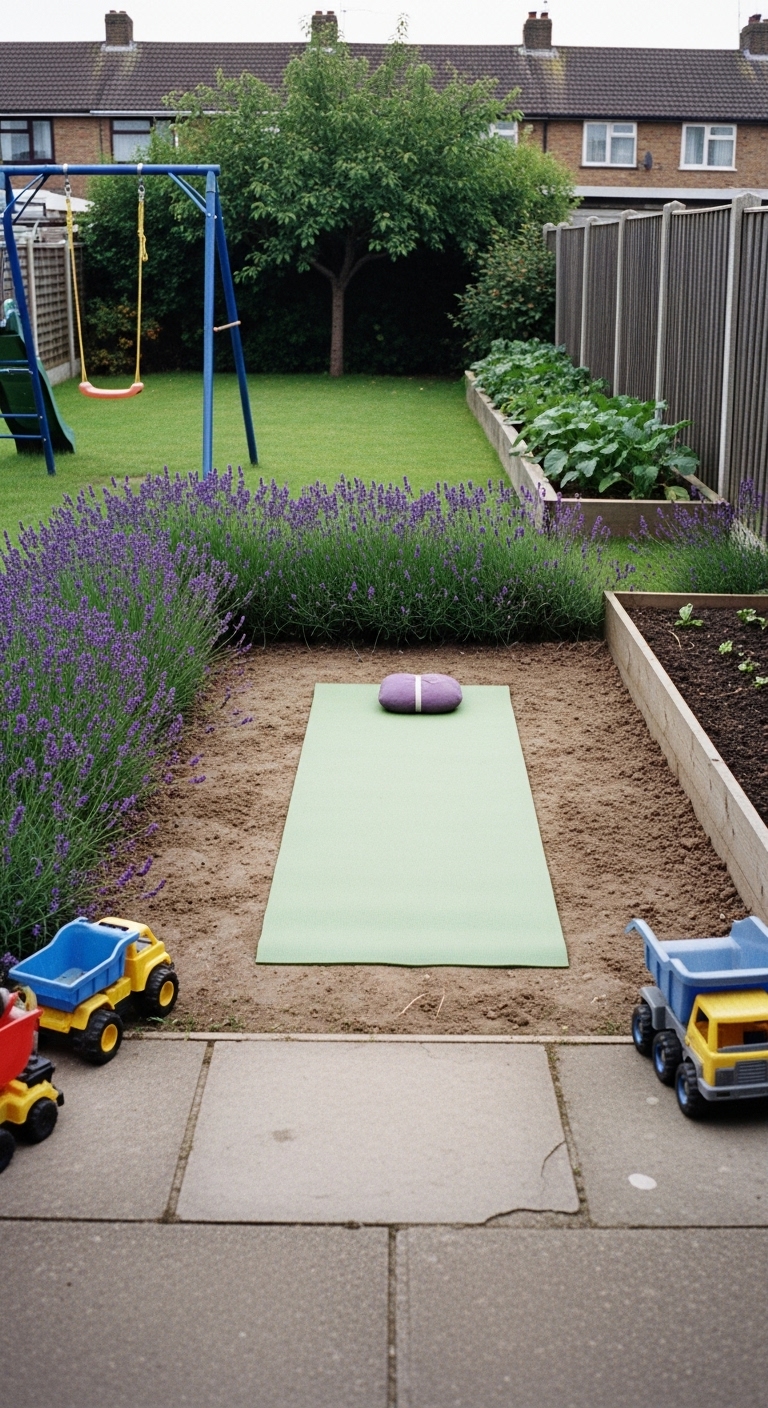
Design Elements for a Yoga and Meditation Garden
Natural Flooring
Your foundation matters. But perfect isn’t necessary.
Grass works beautifully. Bare feet connect directly to earth. Uneven spots challenge balance. Morning dew adds sensory awareness. Just check for hidden rocks or sticks before practice.
Wood decks warm under sun. They’re smooth for flowing sequences. Old boards creak and shift—reminding you to stay present. Even weathered, splintery decks work with a good mat on top.
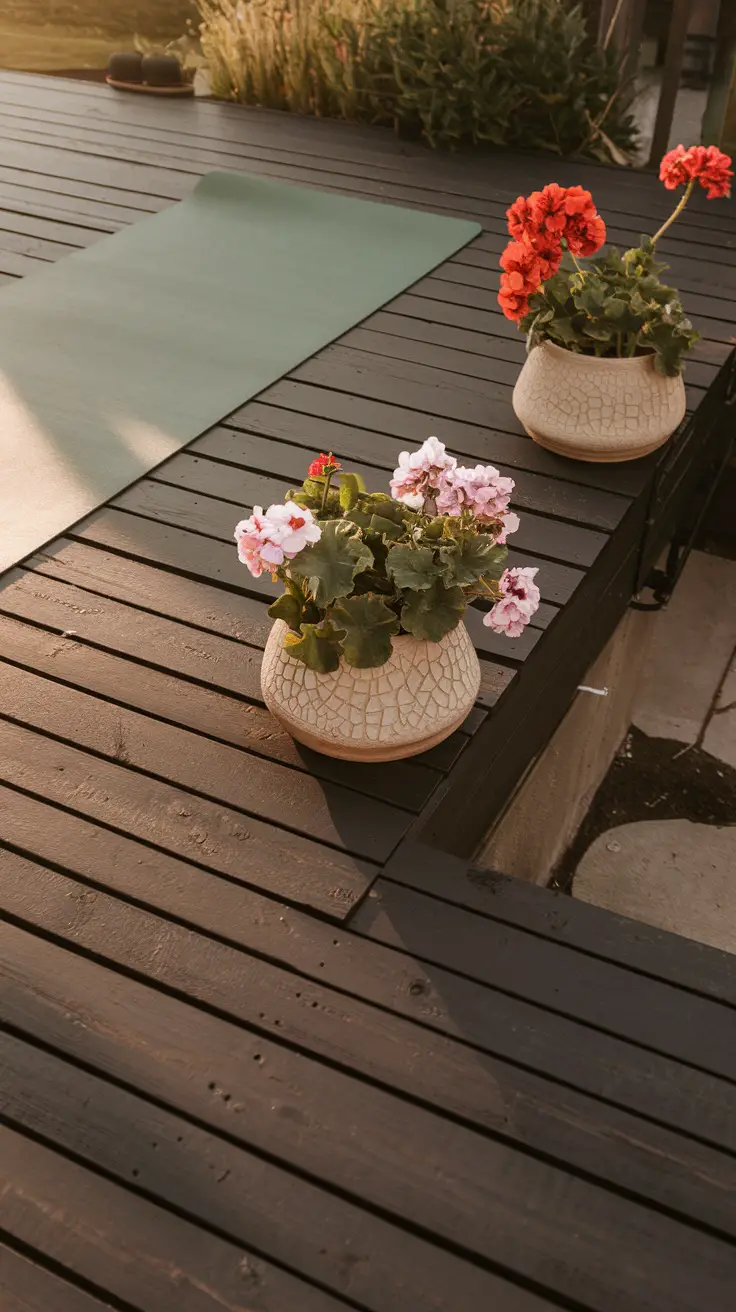
Stone pavers create permanent spaces. They stay cool in heat, warm in sun. Irregular flagstone adds natural beauty. Even mismatched concrete blocks work—spray paint them earth tones if needed.
Bamboo mats bring studio feel outdoors. They roll up for weather protection. Layer them over rough surfaces. Replace cheaply when worn.
Shelter and Shading
Sun feels good until it doesn’t. Smart shading keeps your yoga garden aesthetic comfortable year-round.
Trees offer living shelter. Their shadows shift with time, teaching impermanence. Branches frame sky views during restorative poses. Even half-dead trees provide something—character, if not full shade.
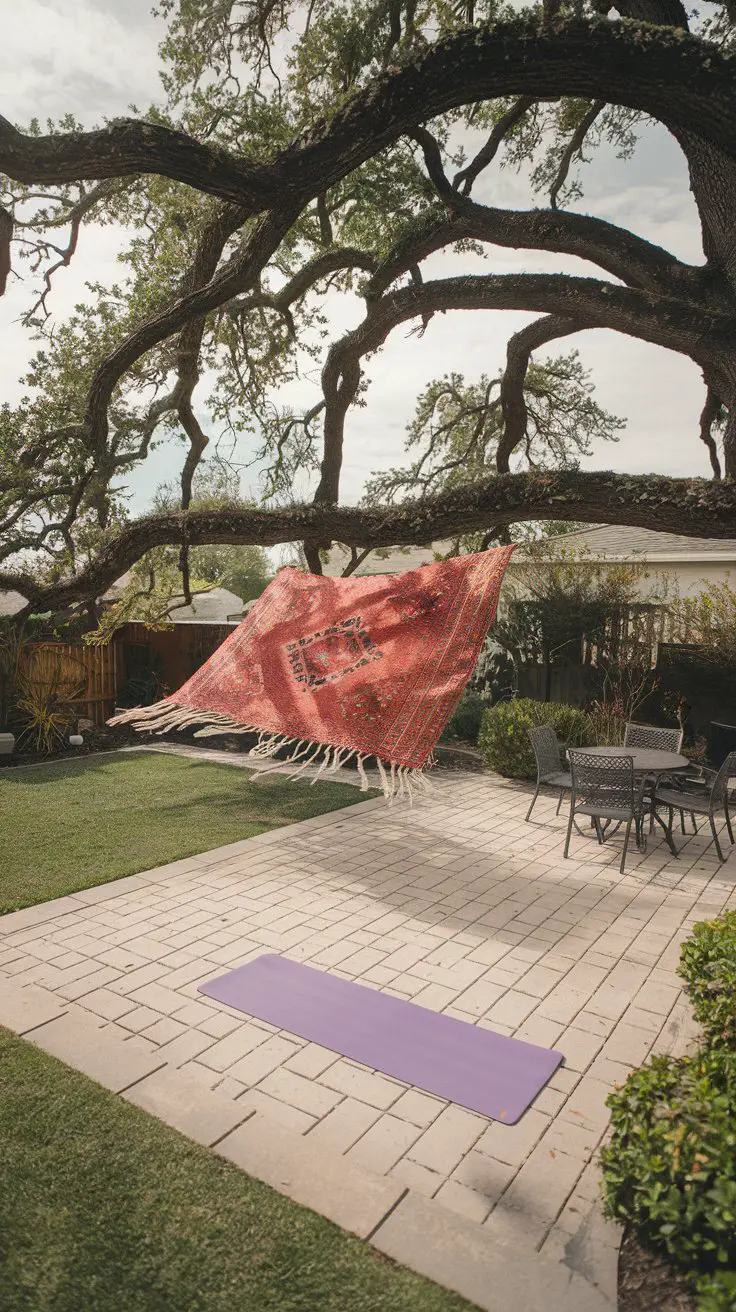
Pergolas don’t need perfection. Four posts and some crossbeams create structure. Grow vines for living walls. Or string old bedsheets for instant shade.
Simple solutions work:
- Beach umbrella in a bucket of sand
- Shade sail tied to fence posts
- Pop-up canopy from garage sales
- Natural arbors from bent branches
Water Features
Water transforms space. But you don’t need elaborate fountains.
A simple bird bath brings sound and movement. Fill it fresh each session. Watch birds arrive during meditation. Even a cracked one works—just keep water levels low.
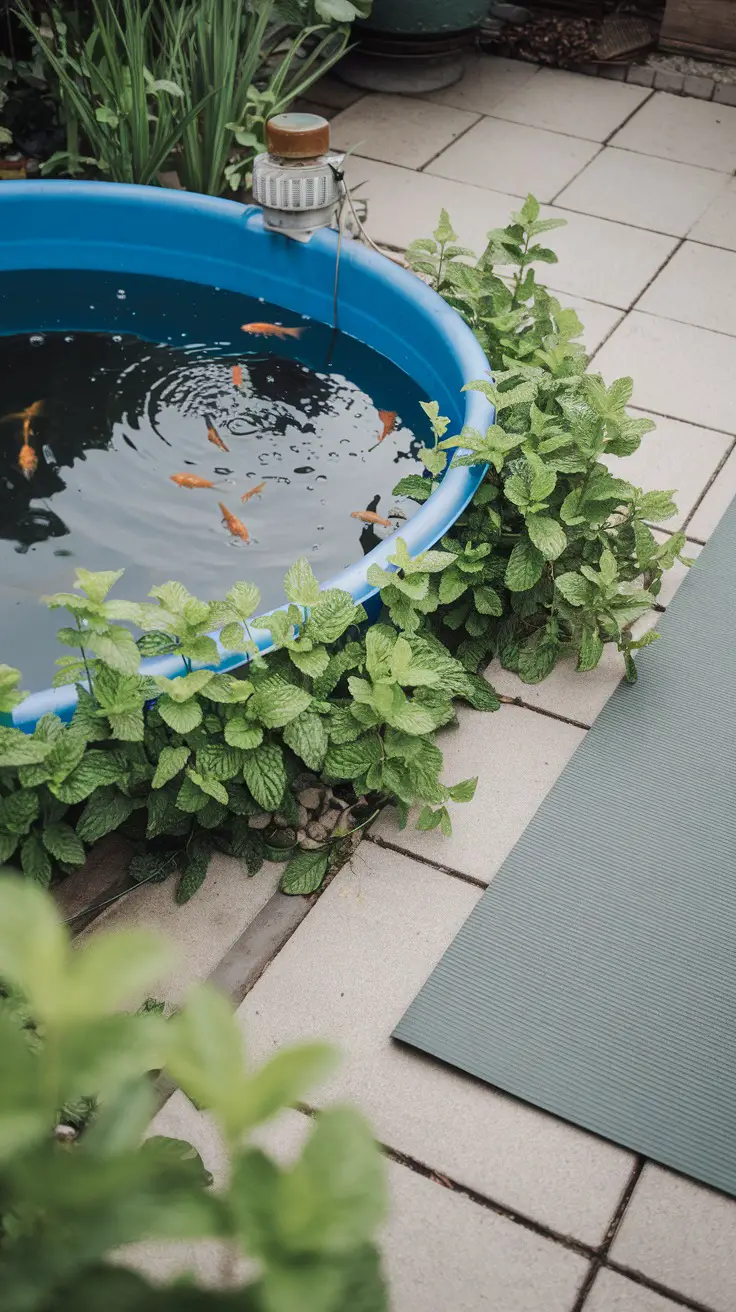
DIY fountain ideas:
- Ceramic pot with small pump ($30)
- Stacked stones with hidden tubing
- Repurposed watering can trickling into bucket
- Simple bamboo spout over pebbles
No electricity? Use solar pumps. Or just place bowls of water strategically. The stillness reflects sky. Change them daily as ritual.
Lighting
Early morning needs no help. But evening practice requires gentle illumination.
Avoid harsh floods. Your yoga in the garden aesthetic calls for soft, natural light. Think glow, not glare.
String lights work magic. Drape them loosely—perfection isn’t the goal. Mix warm white with colored bulbs for variety. When bulbs die, leave some dark. It adds character.
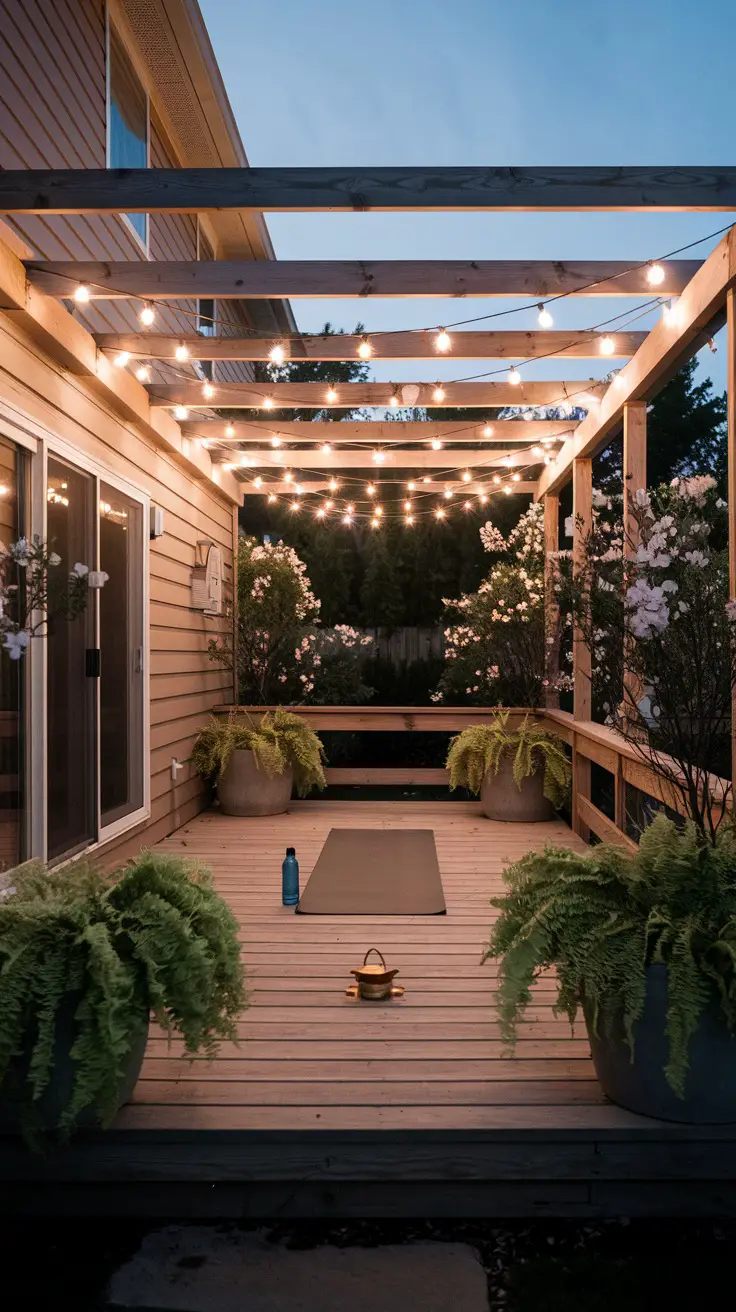
Other options:
- Candles in glass jars (safe from wind)
- Solar lanterns from discount stores
- LED stakes along pathways
- Fire pit for winter practice (at safe distance)
Plant Selection for Serenity
Plants set mood. But they don’t need constant perfection.
Lavender forgives neglect. It spreads naturally, creating purple borders. Bees love it. So do yogis. Let it grow wild between planned spaces.
Jasmine climbs anything—fences, posts, dead trees. Night-blooming varieties perfume evening sessions. Star jasmine stays evergreen in mild climates.
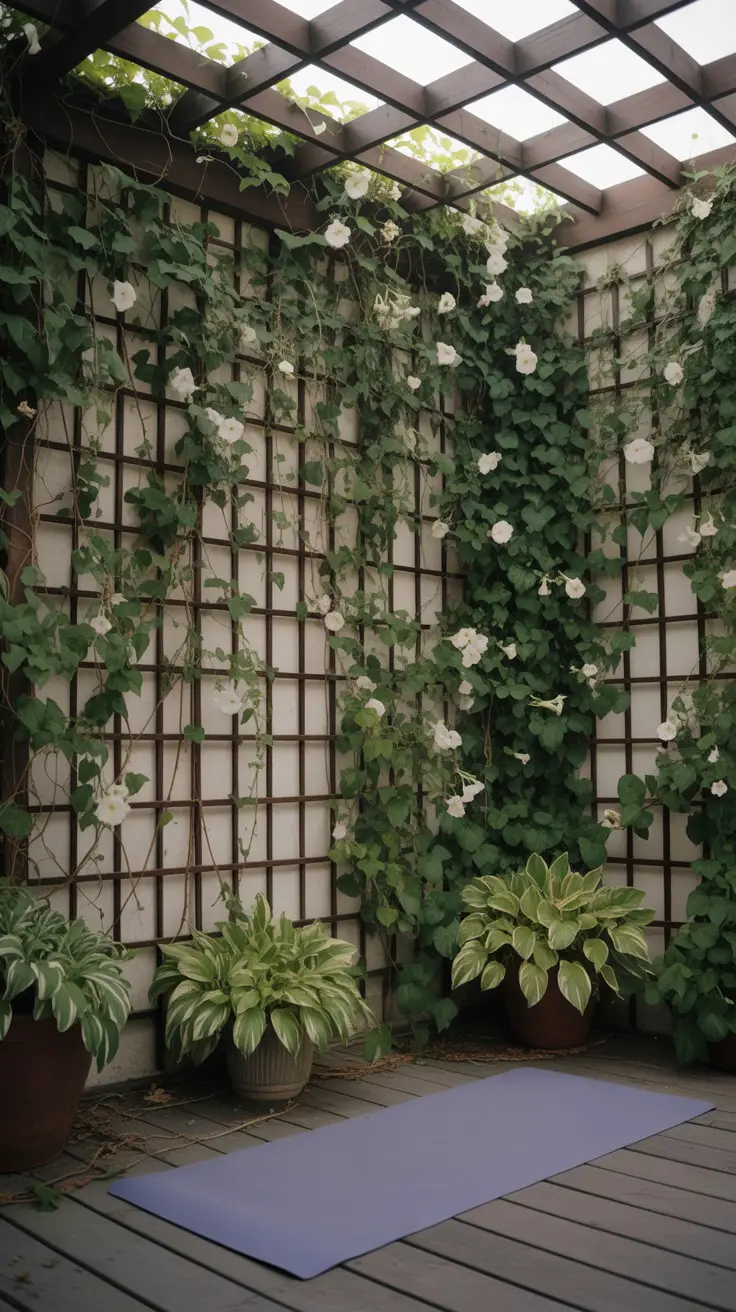
Easy-care options:
- Bamboo: Creates natural screens, sounds peaceful in wind
- Ferns: Thrive in shade, add prehistoric calm
- Mint: Spreads everywhere (contain it!), smells amazing
- Rosemary: Drought-tolerant, energizing scent
- Sage: Sacred associations, easy growing
Let some areas grow wild. Perfection creates pressure. Boho-garden yoga space aesthetics embrace natural chaos.
Aesthetic Touches
Small details personalize your space without breaking budgets.
Sculptures don’t mean expensive art. Stack river rocks. Arrange driftwood. That broken garden statue? Perfect when half-hidden by vines.
Prayer flags fade beautifully. Hang them loose. Let weather do its work. When they tatter, leave them—wabi-sabi in action.
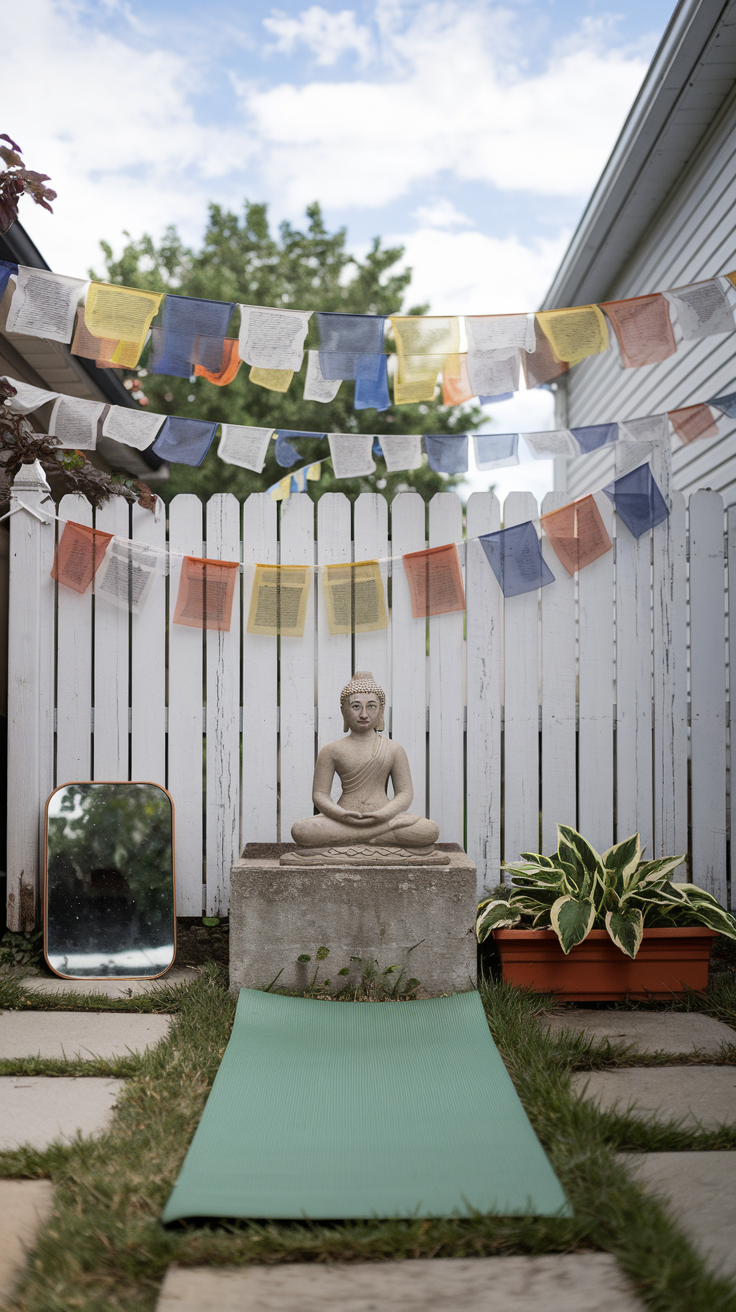
Found object ideas:
- Old mirrors reflect light and space
- Weathered wood becomes altar platforms
- Collected stones mark practice boundaries
- Thrift store statues add focal points
- Wind chimes from broken jewelry
Types of Yoga Garden Spaces
Yoga Garden Backyard Studio
The ultimate luxury—a dedicated structure. But “studio” doesn’t mean professional.
Converted sheds work brilliantly. Clear out mowers and rakes. Add windows if possible. Even just screening walls transforms storage to sanctuary.
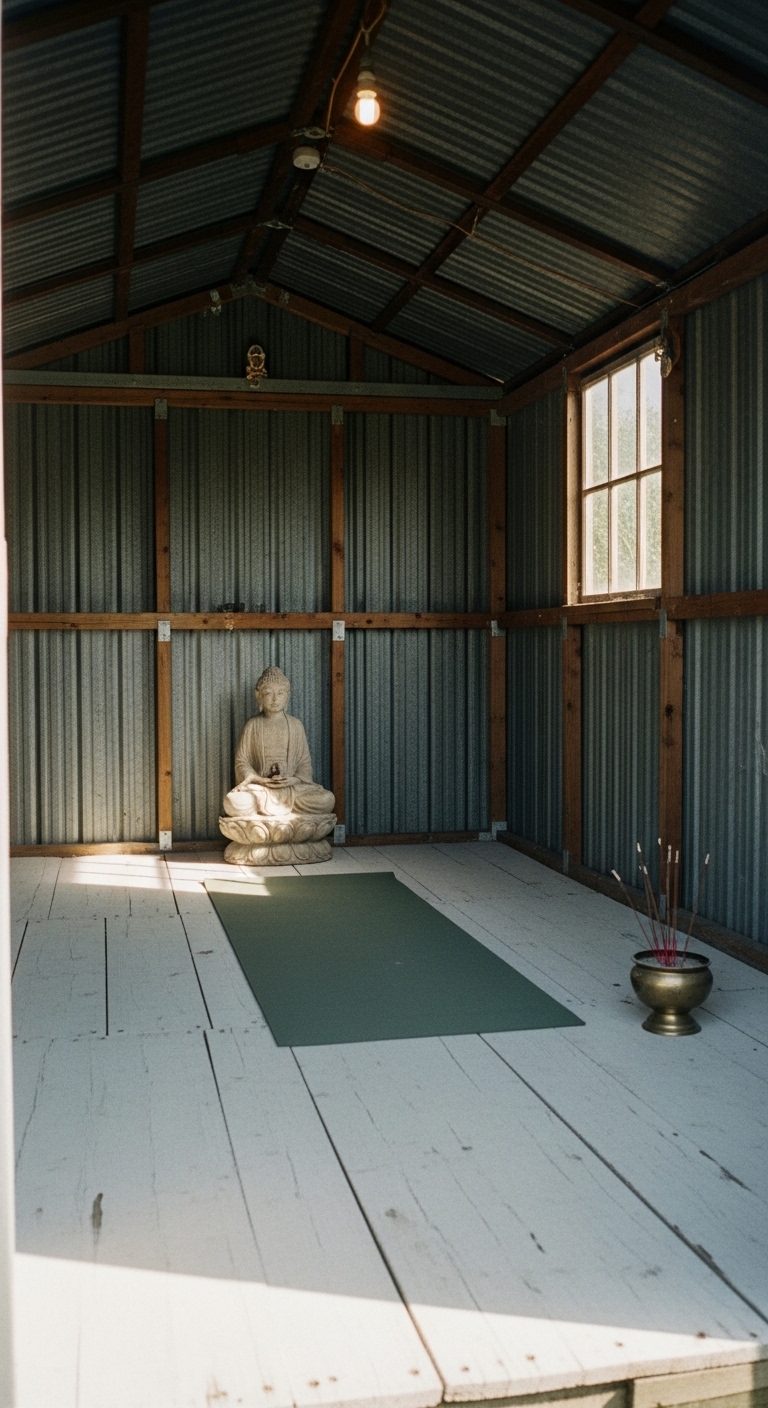
Greenhouse structures create magic. Glass walls merge indoor-outdoor boundaries. Used ones sell cheap. Missing panels? Hang fabric. Cracked glass? Adds character.
Budget studio options:
- Converted garage corner ($100-500)
- Screened gazebo from classifieds ($200-800)
- DIY hoop house with plastic sheeting ($150-400)
- Repurposed camper or trailer ($500-2000)
Your yoga garden studio needs only basics: protection from weather, enough space to move, and connection to nature.
Yoga Garden Corner
Sometimes a corner is enough. Actually, sometimes it’s perfect.
That forgotten spot behind the garage. The weird angle where fences meet. Under the deck stairs. These become intimate practice spaces.
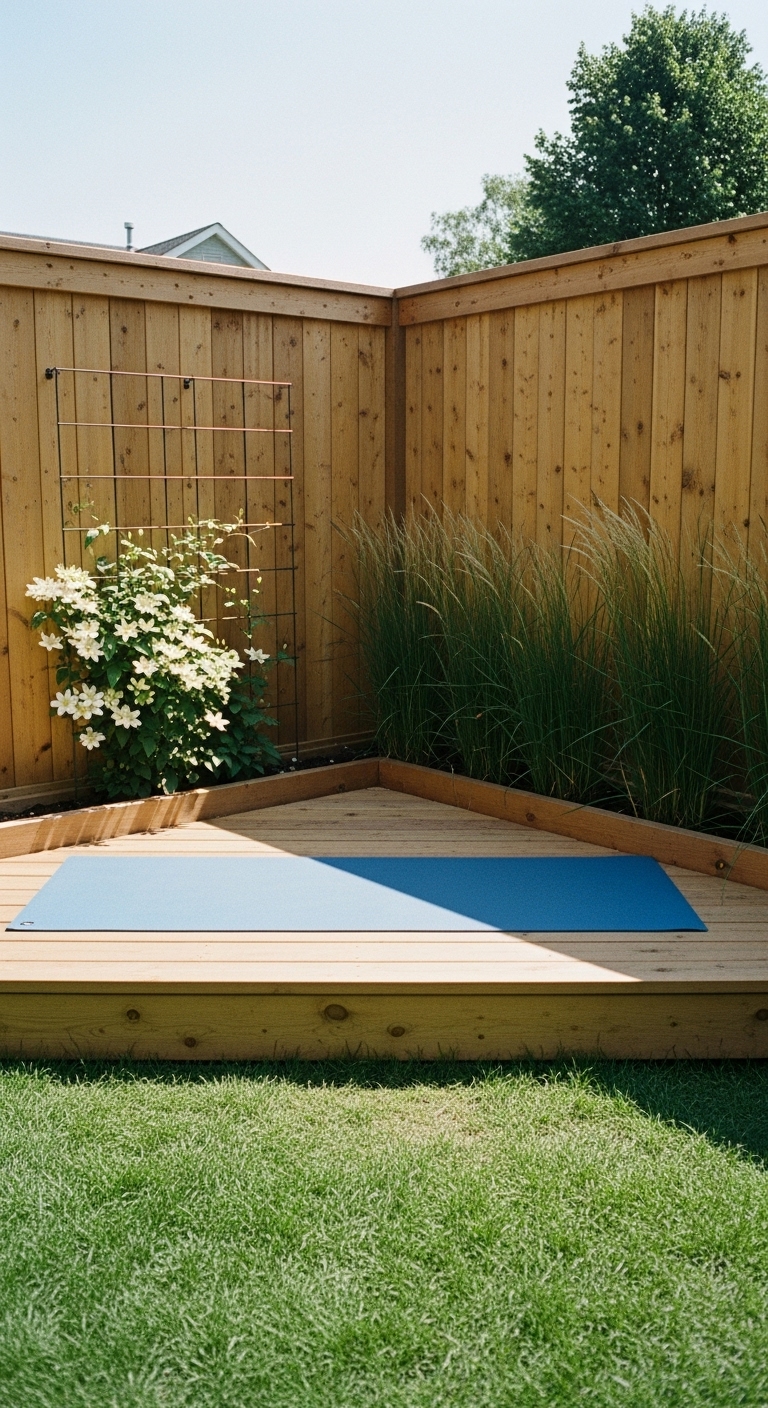
Define your yoga garden corner simply:
- Different ground covering than surroundings
- Plant borders (even just potted)
- Hanging fabric for privacy
- Small altar or focal object
Keep it minimal. Corners accumulate stuff naturally. Fight the urge to fill space.
Multi-use Garden Yoga Space
Real life means shared spaces. Your yoga area might host barbecues, kid play, dog zoomies.
Design for flexibility. Use moveable elements. Accept that toys will migrate into your zen zone. That’s life.
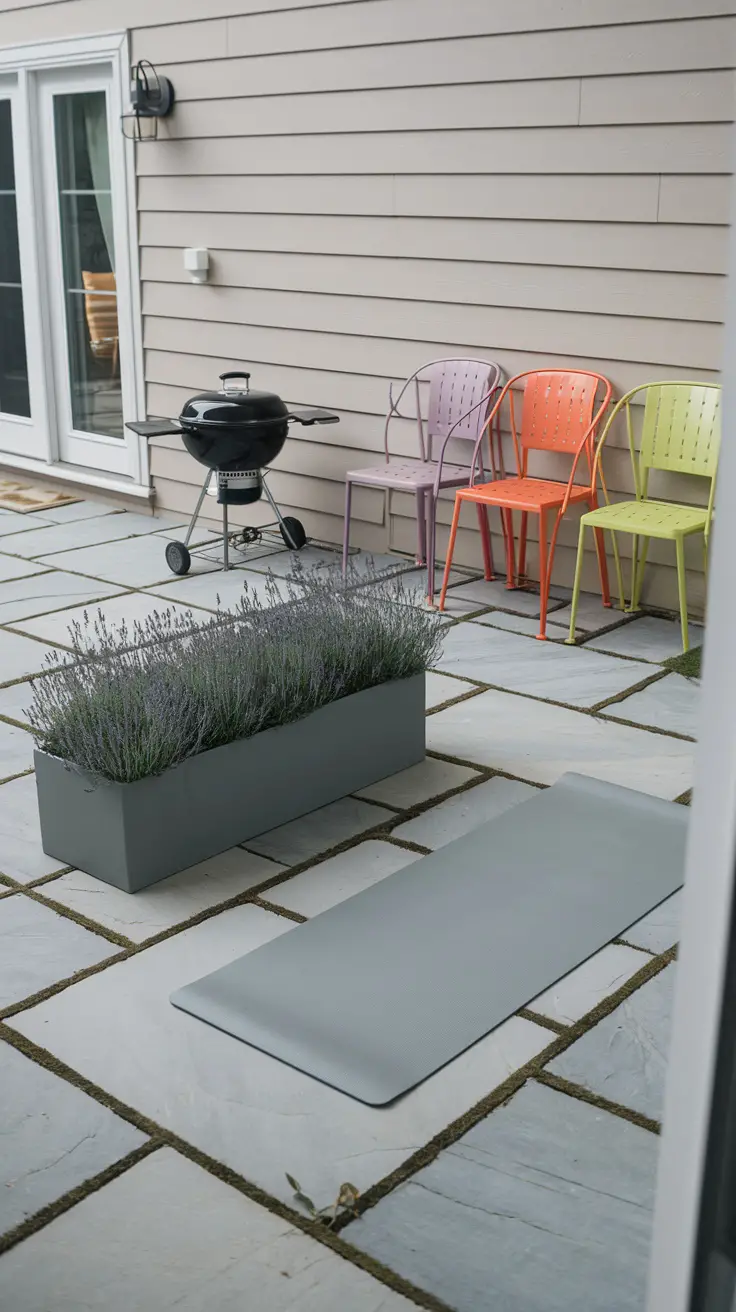
Multi-use tips:
- Rollaway mats store easily
- Folding screens create instant boundaries
- Wheeled planters define space temporarily
- Stackable elements maximize flexibility
Your garden yoga space backyards reality includes family life. Embrace it.
Portable Yoga Garden Setup
Renters rejoice. Portable setups go anywhere.
Everything stays mobile. Mats roll. Screens fold. Plants live in containers. When leases end, your sacred space travels too.
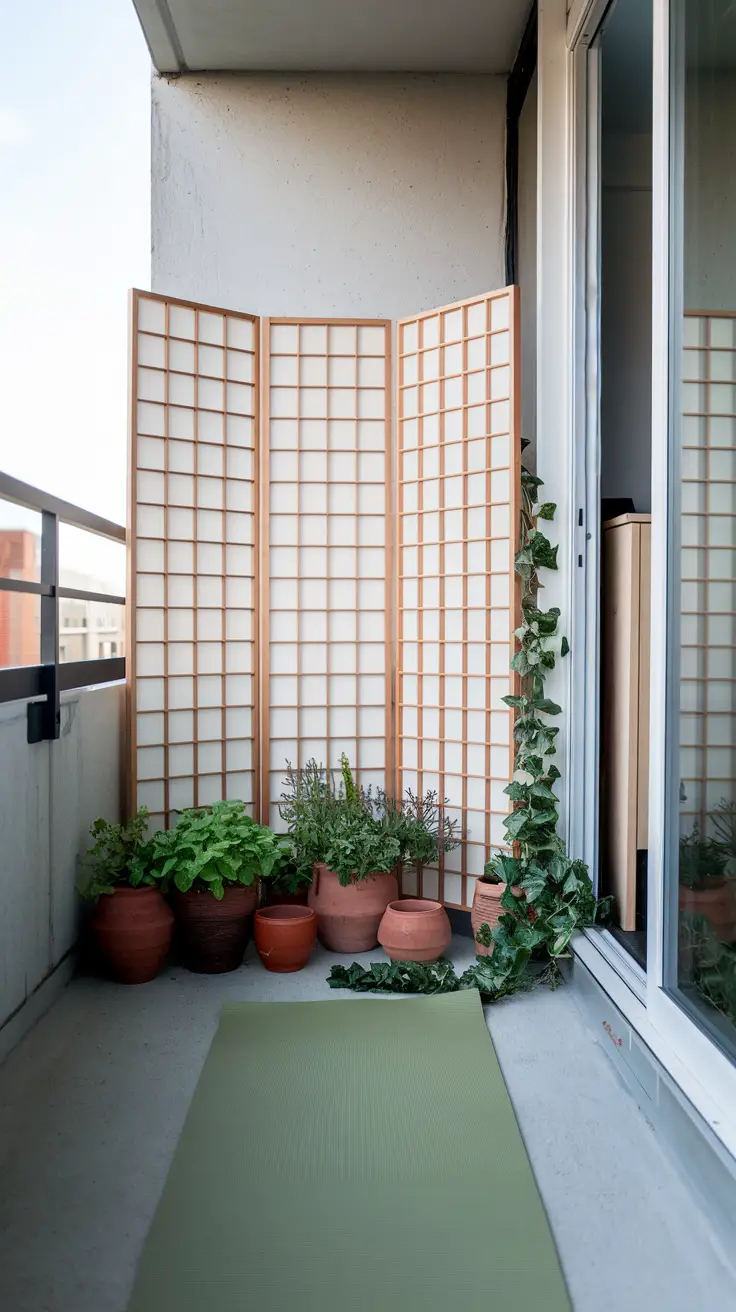
Portable essentials:
- Lightweight outdoor rug
- Collapsible shade structure
- Container garden on wheels
- Folding meditation bench
- Battery-powered string lights
Yoga Room with Garden Views
Sometimes weather wins. An indoor yoga garden room with nature views offers compromise.
Any room works with the right window. Clear furniture from sightlines. Position mats to face green views. Open windows wide for air flow.
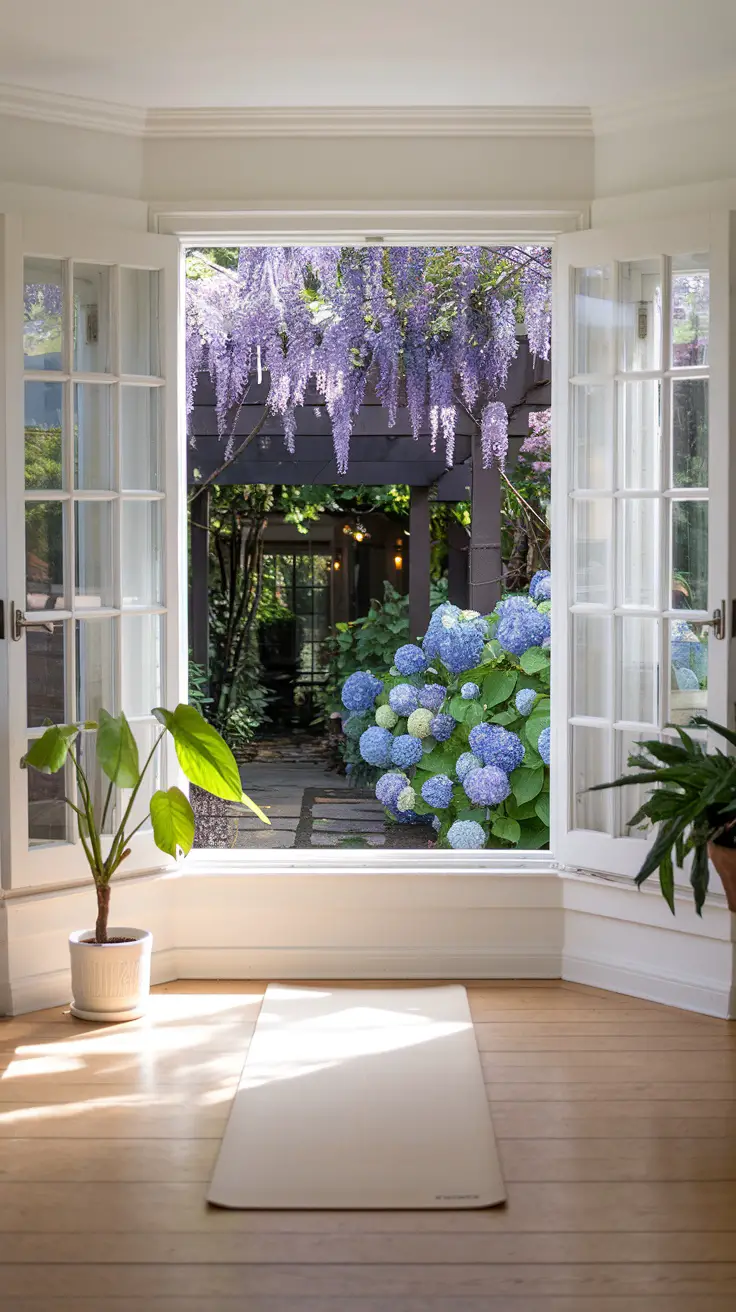
Bring outside in:
- Potted plants near practice space
- Natural materials (wood, stone, fiber)
- Nature sounds through open windows
- Fresh air flow prioritized over temperature control
Creating a Meditation-Focused Yoga Garden
Blending Movement and Stillness
Yoga and meditation garden spaces serve both practices. But they need different energies.
Movement areas want openness. Room to stretch, flow, balance. Meditation spots crave intimacy. Enclosed feelings help minds settle.

Design both into your space:
- Open area for physical practice
- Sheltered nook for sitting
- Transition zone between them
- Shared elements (like water features) connecting both
Features Supporting Mindfulness
Zen elements don’t require perfection. Sometimes imperfection teaches more.
Sand gardens calm busy minds. Use a shallow box or ground-level frame. Play sand works fine. Rake patterns with a fork. When rain destroys designs, start fresh.
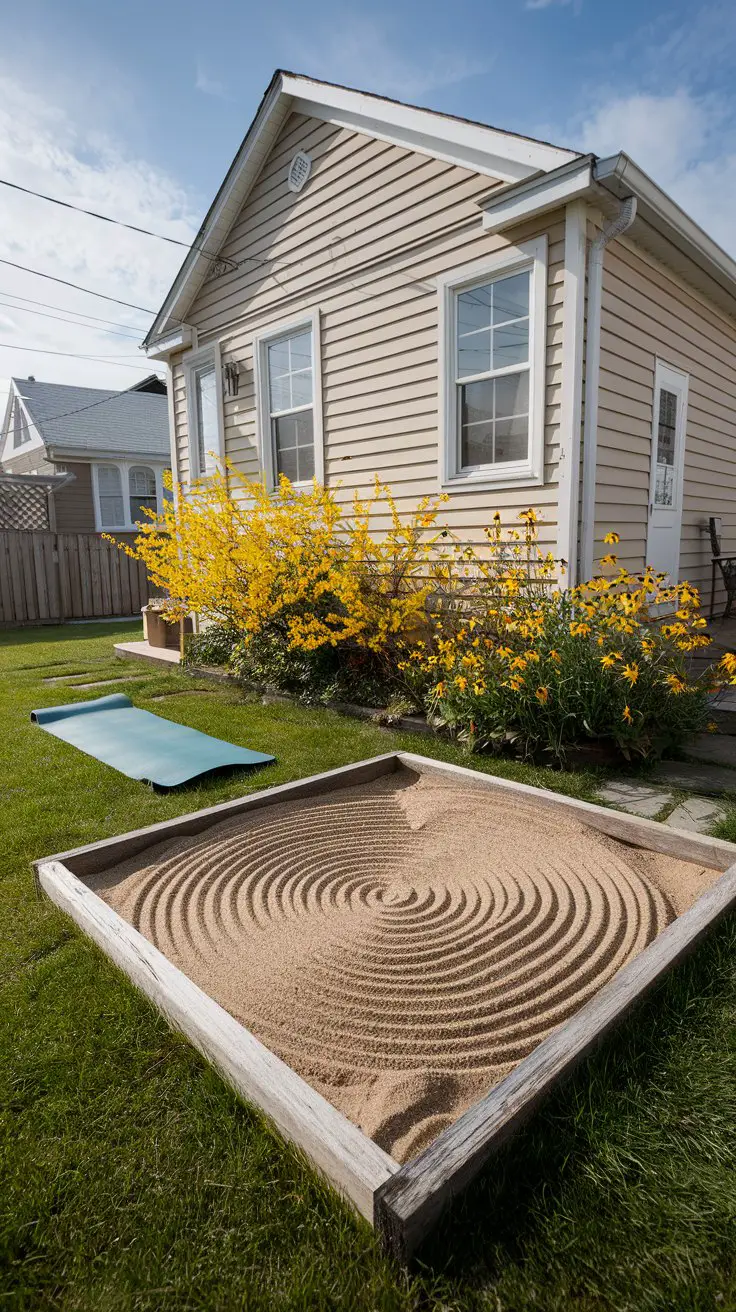
Stone arrangements ground energy. Collect rocks on walks. Stack them intuitively. When they fall, restack. The process matters more than results.
Wind chimes mark breath rhythm. Hang them where breezes play. Broken chimes? Remove some tubes for gentler sounds.
Seating Zones
Meditation needs comfortable seats. But “comfortable” varies by person and practice.
Benches work for supported sitting. Build from scrap wood or repurpose indoor furniture. Weather adds character. Cushions help aging joints.
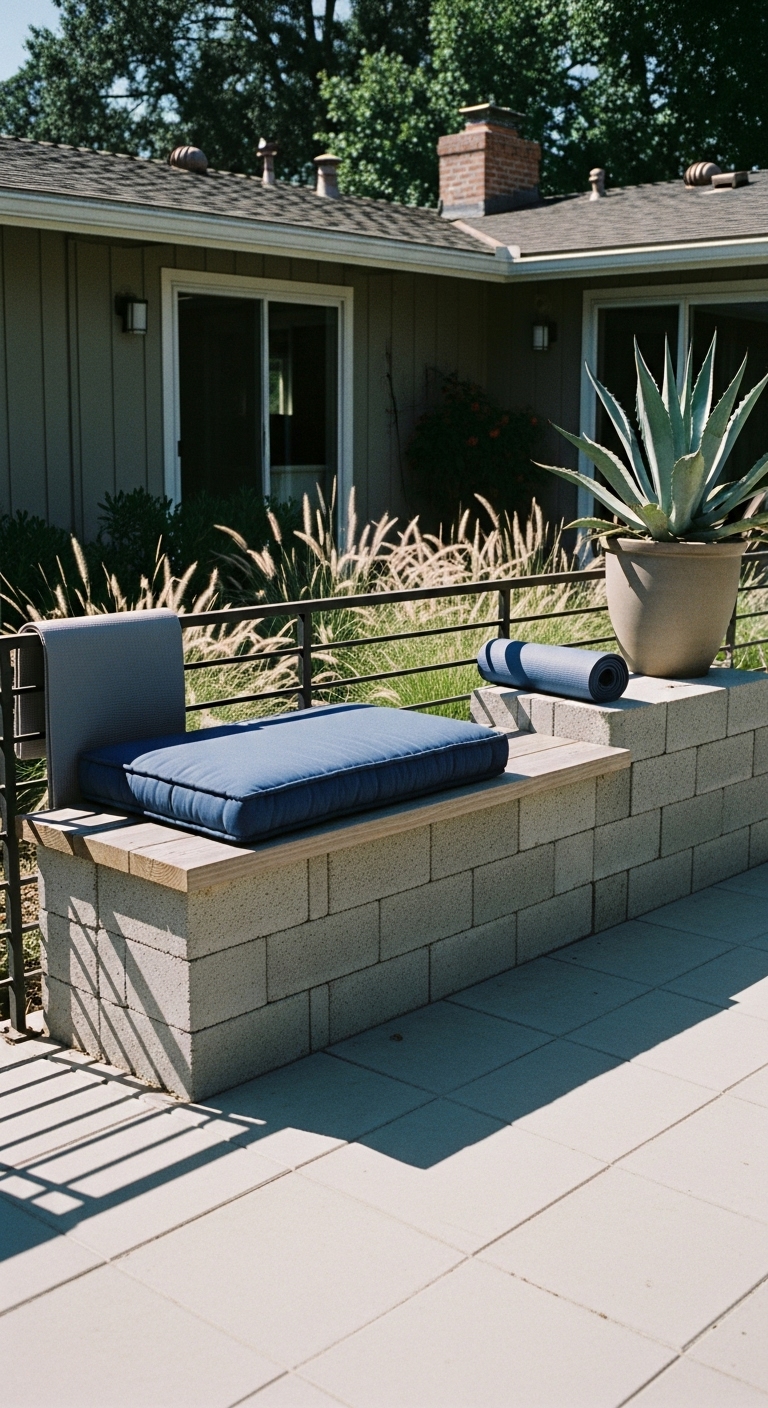
Ground seating options:
- Meditation cushions (store inside between uses)
- Folded blankets on waterproof tarps
- Tree stumps at proper height
- Foam gardening pads
- Hammocks for reclined meditation
Create multiple spots. Morning sun hits differently than evening shade. Winter wants shelter. Summer seeks breeze.
Sacred Symbols and Focal Points
Every yoga garden area needs an anchor—something that draws focus and sets intention.
Altars emerge naturally. A flat stone holds found objects. Flowers from the garden. Candles in jars. Photos that inspire. Change elements seasonally or daily.
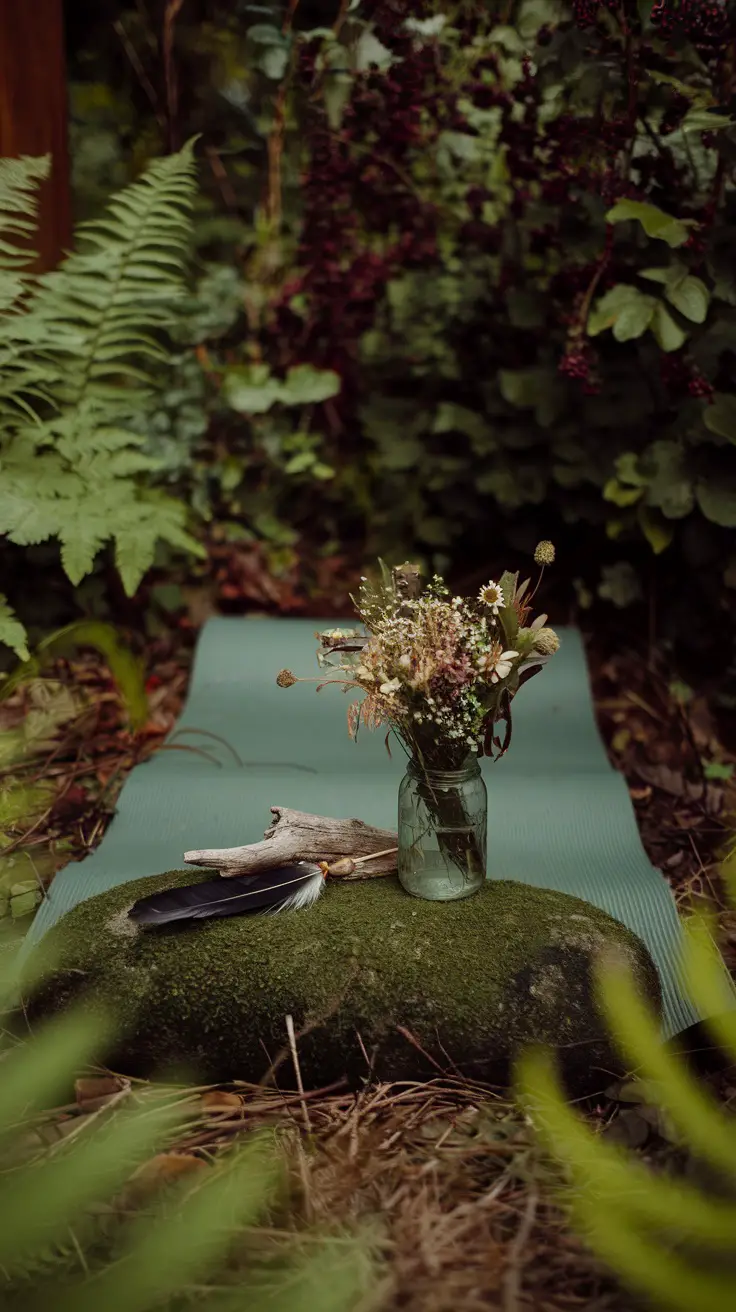
Statues don’t need to be precious. That concrete garden gnome? Paint it gold and call it Buddha. Thrift stores hide treasures. Weather and time add patina.
Simple focal points:
- Single beautiful plant
- Interesting rock or crystal
- Mirror reflecting sky
- Written intention on weatherproof paper
- Empty space framed by plants
Let symbols evolve. What speaks to you in spring might feel wrong by fall. Yoga in a garden means accepting natural cycles.
Seasonal and Lifestyle Adaptations
Year-Round Use
Gardens change. Your practice adapts.
Summer heat demands early morning or late evening sessions. Find shade or embrace the sweat. Hydration stations become essential—keep water bottles in shadow. Mosquito coils burn at safe distances.
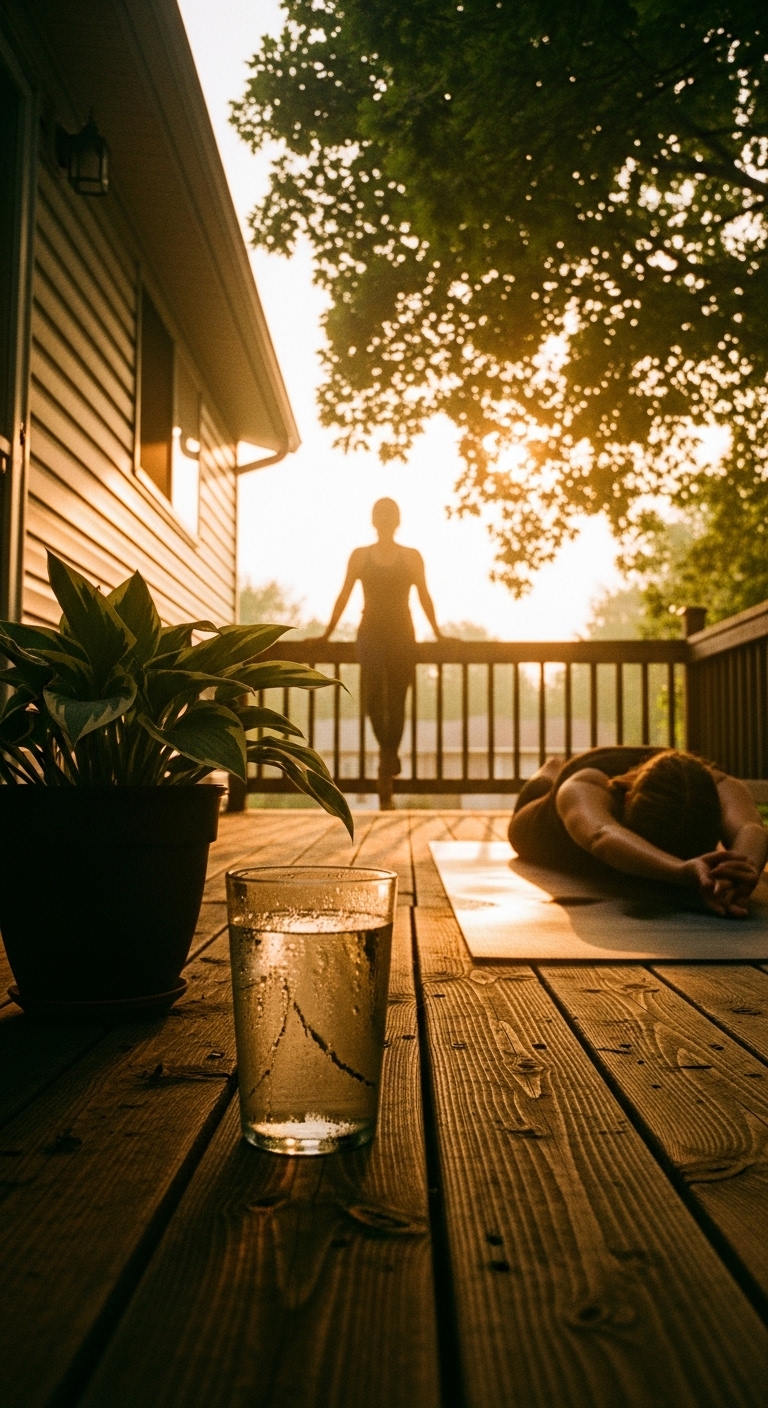
Autumn brings different magic. Leaves fall during practice—let them. Cool air sharpens focus. Layer clothing for temperature shifts. That pile of raked leaves? Perfect for supported poses.
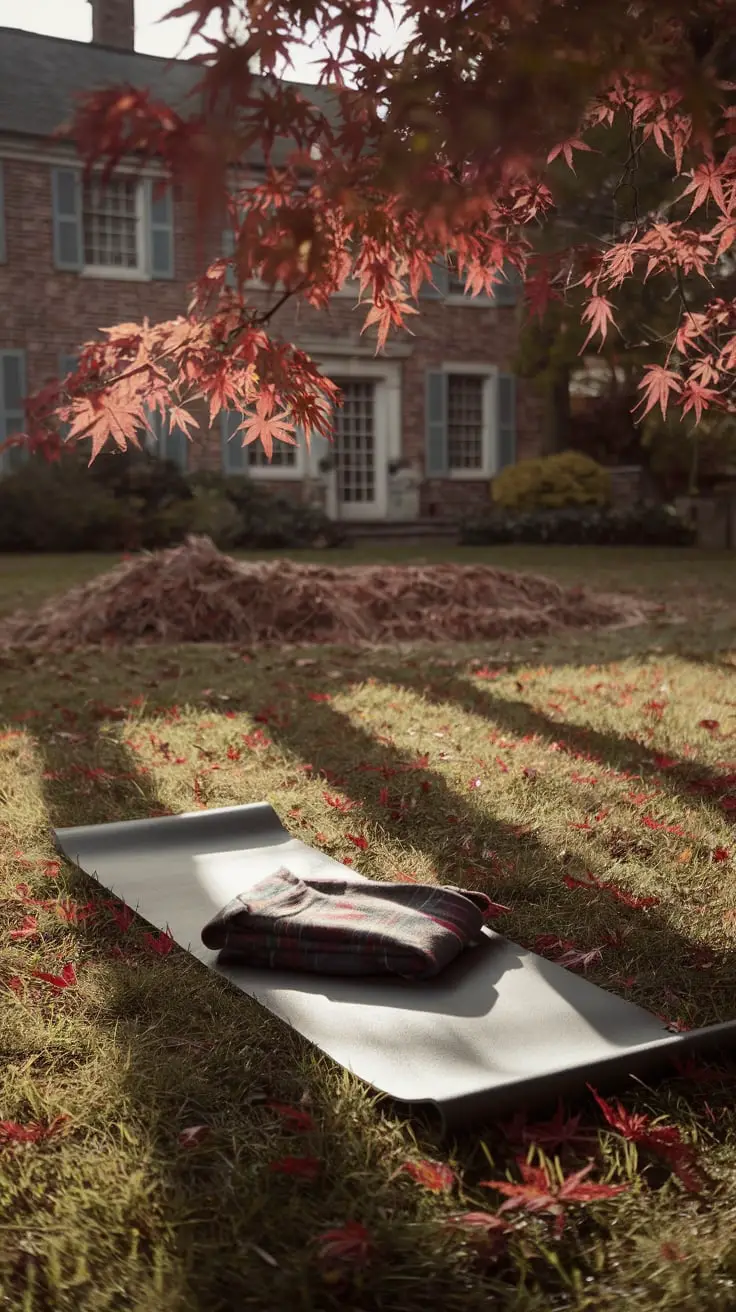
Winter tests dedication. But cold air wakes every cell. Short sessions work better than long holds. Keep moving between poses. Hot tea waits in a thermos nearby.
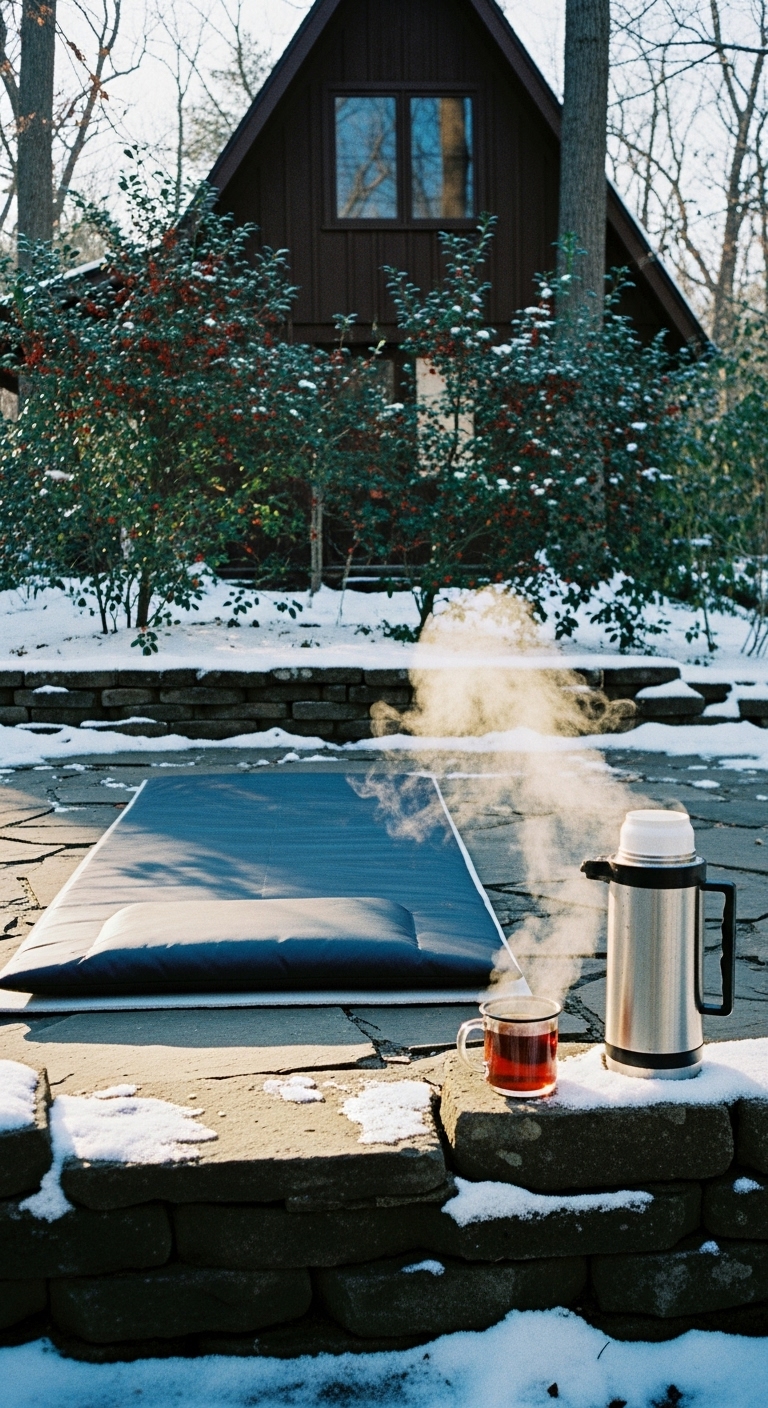
Spring means mud. Embrace it. Waterproof mats help. Or practice barefoot and hose off after. New growth inspires fresh starts. Allergies might require indoor backup plans.
Sunrise and Sunset Practice
Yoga by the garden at golden hours transforms everything. But timing takes planning.
Dawn practice means preparing the night before. Set out mats, props, layers. Coffee can wait until after. The quiet rewards early rising. Birds provide soundtrack. Dew adds sensory elements.
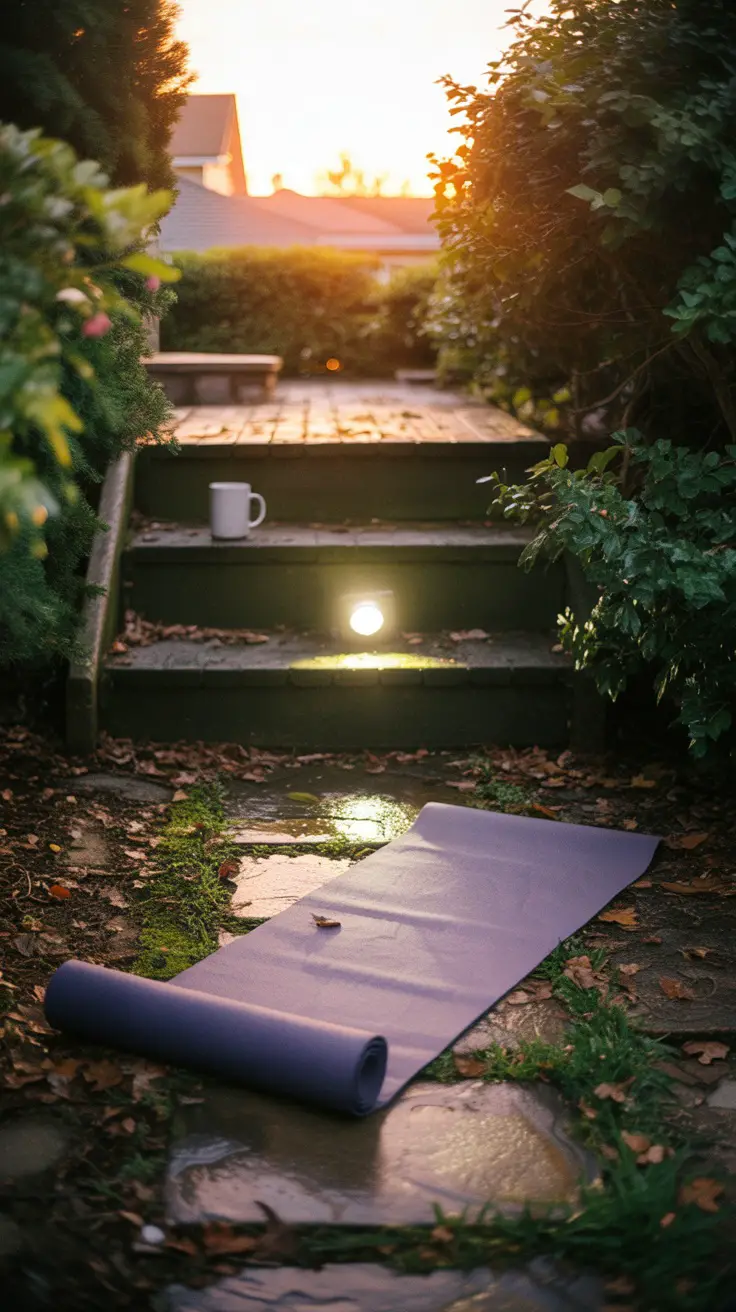
Sunset sessions fight schedules. Dinner prep calls. Emails ping. But magic happens when you resist. Light softens. Temperature drops. Day’s stress releases with each breath.
Adjust for light:
- East-facing spaces for morning
- West views for evening
- Portable setups to chase conditions
- Reflective surfaces to maximize glow
Family and Group Practice
Garden yoga spaces backyards often host more than solo practice. Design for community.
Kids join naturally. Give them their own mats. Or not—let them wander through your poses. Their giggles become meditation bells. Perfectionism dies quickly with toddlers around.
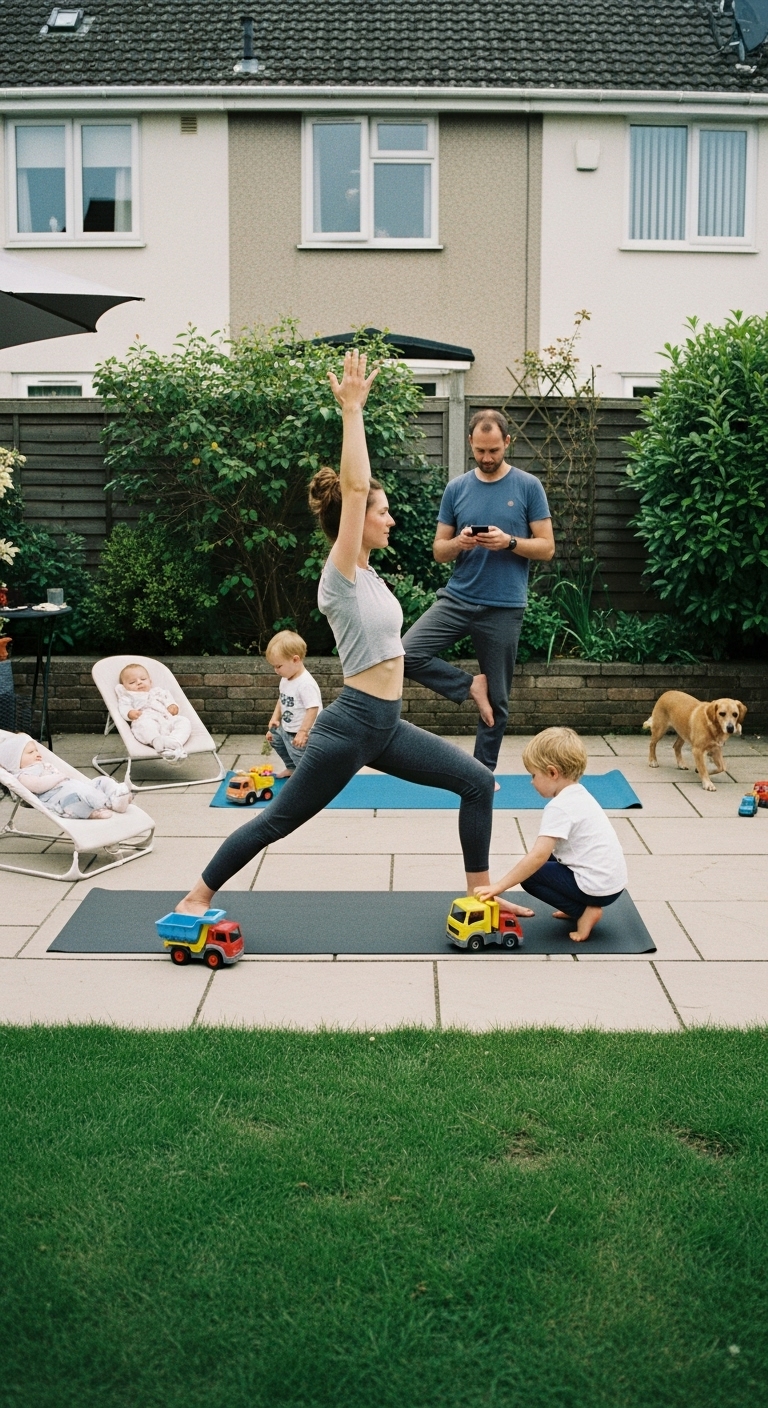
Group sessions need more room. Test spacing before inviting friends. Mark spots with stones or stakes. Uneven ground? Make it part of the practice—balance challenges for everyone.
Consider:
- Multiple level areas for different abilities
- Prop storage accessible to all
- Clear pathways between mats
- Shade for sensitive participants
Solo Retreat Corners
Sometimes you need solitude. A yoga corner in garden just for you.
This space stays smaller, more hidden. Maybe behind the shed. Under the deck. That awkward side yard. Somewhere family knows means “do not disturb.”
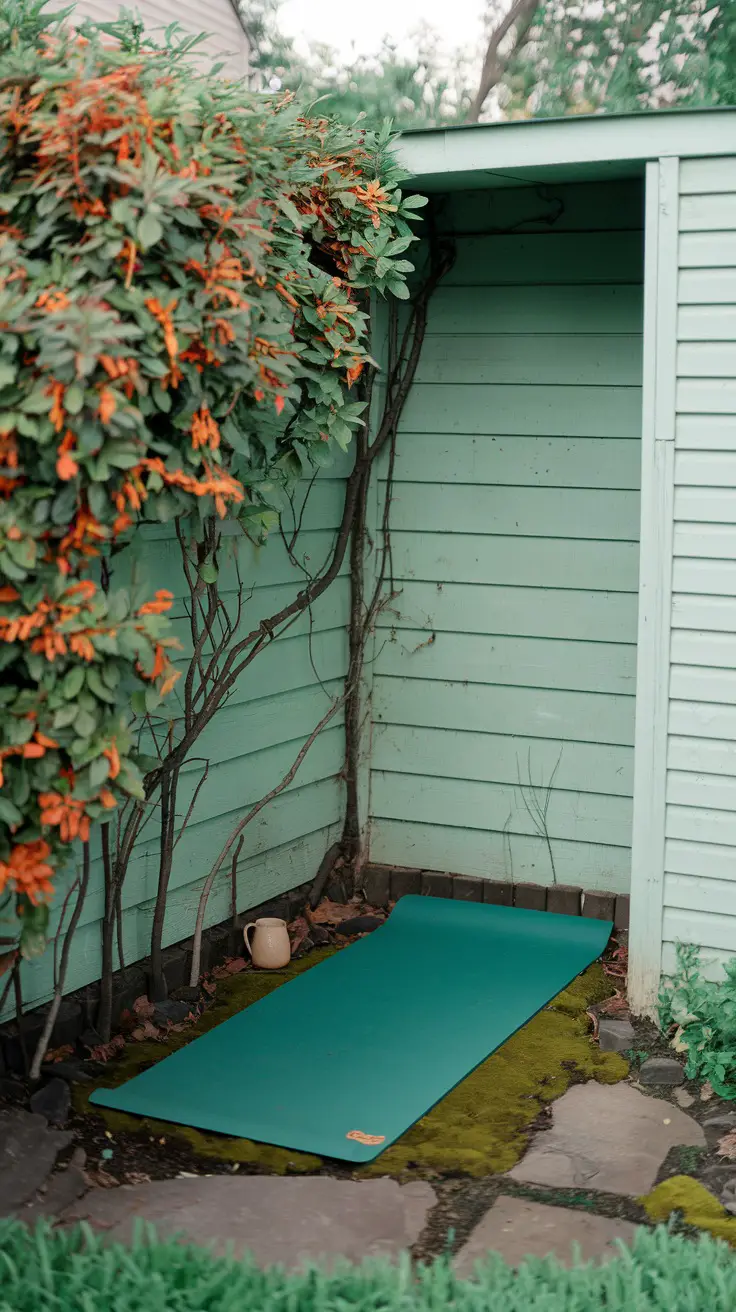
Protect solo time:
- Communicate boundaries clearly
- Create visual barriers (screens, plants)
- Establish practice schedules
- Keep the space minimal—less to maintain
Daily rituals build in these corners. Five minutes becomes sacred. The space holds your practice even when you’re absent.
Tips for Beginners: Making the Most of Your Yoga Garden
Start Small
Big dreams kill small starts. Begin with what you have.
One yoga mat plus three potted plants equals a garden practice. That’s it. Everything else is extra. Place mat on grass, deck, or driveway. Add one plant you love. Practice once. You’ve begun.
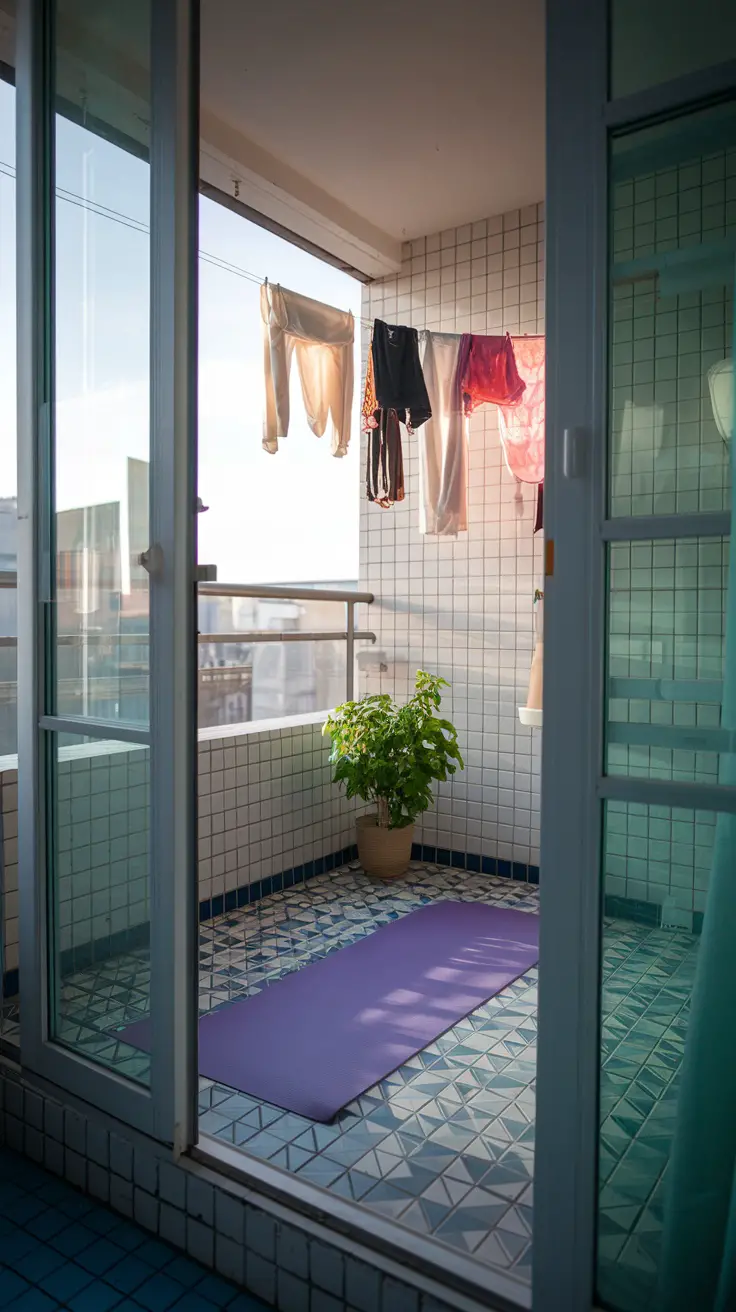
Build slowly:
- Week 1: Mat plus one plant
- Week 2: Add a cushion or blanket
- Week 3: Hang one string of lights
- Week 4: Place a special stone or shell
Each addition should earn its place through use. Yoga garden space ideas grow from practice, not planning.
Natural Soundscapes
Skip the speakers. Nature provides better playlists.
Birds change songs with seasons. Wind plays different tunes through different plants. Rain on leaves beats any recorded storm. Even traffic becomes white noise with acceptance.
Enhance natural sounds:
- Hang multiple wind chimes at different heights
- Add grasses that whisper in breeze
- Create water features for constant flow
- Plant flowers that attract hummingbirds
Silence works too. Early morning often gifts quiet moments. Embrace them fully.
Consistency Beats Perfection
Yoga in garden backyards succeeds through showing up, not showing off.
Same time daily works best. Bodies learn rhythms. Gardens reveal patterns. Even five minutes counts if it’s consistent. Mark calendar days you practice. Watch the chain grow.
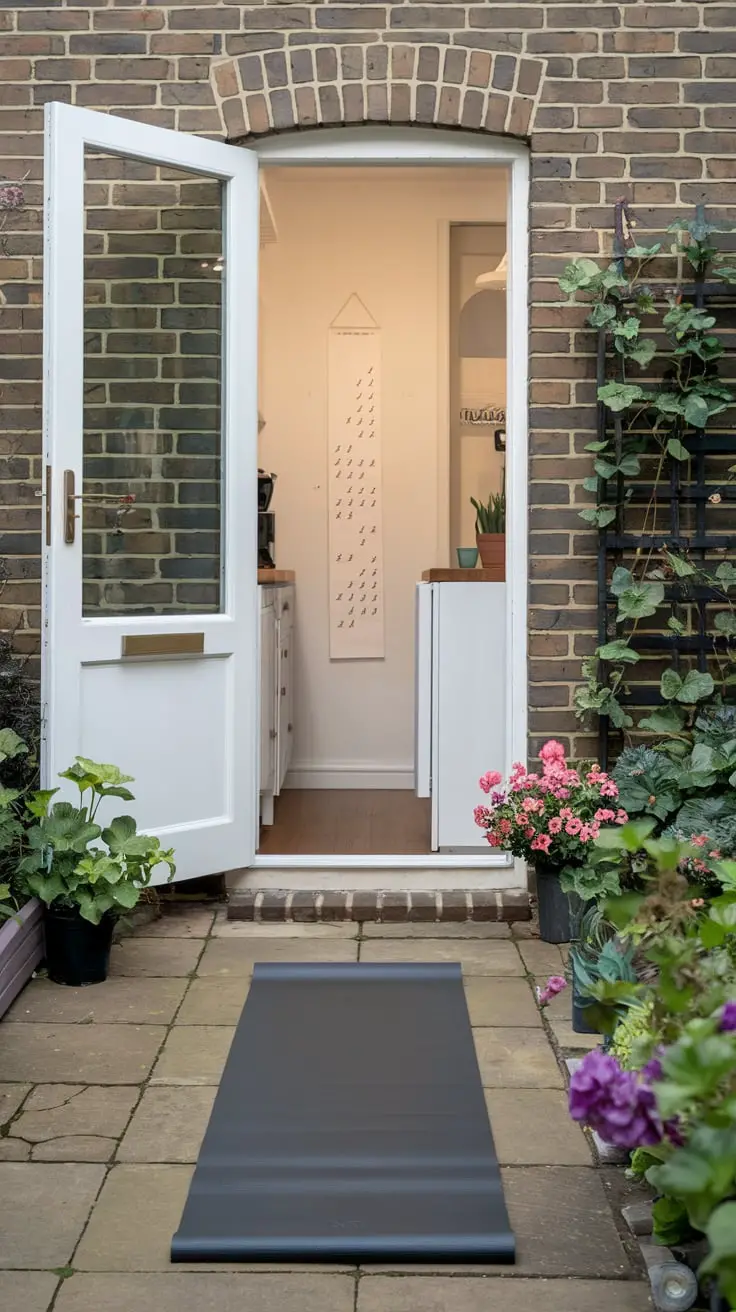
Build habits:
- Link practice to existing routines (after coffee, before shower)
- Start with tiny commitments (three sun salutations)
- Practice regardless of weather (adjust, don’t skip)
- Track consistency, not complexity
Your garden practice grows like plants—slowly, steadily, with occasional spurts.
Affordable Upgrades
Improve your space without credit cards. Creativity beats cash.
Recycled wood makes perfect platforms. Check construction sites for scraps. Sand rough edges. Or don’t—yoga teaches accepting imperfection. Paint optional.

Thrift store treasures:
- Old mirrors for light and space illusion
- Vintage lanterns for evening ambiance
- Worn blankets as outdoor cushions
- Ceramic pots for plants or water features
- Garden statues for focal points
DIY projects:
- Macrame plant hangers from old t-shirts
- Meditation benches from scrap lumber
- Privacy screens from fallen branches
- Garden markers from painted rocks
Remember—yoga in garden aesthetic values authenticity over expense. Worn objects carry stories. Imperfect solutions show creativity.
Now Is the Time to Create Your Yoga Space
Return to that barefoot moment. The garden that invited stillness. Sunlight through leaves. Lavender-scented air. Trickling water.
Now you understand—this garden lives everywhere. In forgotten corners. On apartment balconies. Behind garage walls. Under dying trees. Your yoga garden design already exists. It just waits for recognition.
We’ve explored grand backyard studios and tiny meditation corners. Examined perfect wooden decks and cracked concrete solutions. Every space works when approached with openness.
Gardens teach patience. Plants grow slowly. Seasons cycle endlessly. Your practice will too. Some days, wind knocks over everything. Rain floods your sacred corner. The neighbor’s music destroys meditation.
And that’s the practice.
Real yoga happens in real gardens. Messy, imperfect, alive gardens. Where children interrupt. Dogs dig holes. Weeds always win.
Start tomorrow. Or tonight. Or right now. Step outside. Stand on earth. Breathe deep. You’ve already begun.
Your garden transforms with each practice. Not through expensive additions or perfect planning. But through presence. Through returning. Through accepting what is while nurturing what might grow.
Every breath taken outdoors syncs you with nature’s rhythm. Every pose grounds you deeper. Every meditation connects you to the living world.
Welcome to your yoga garden. However humble. However chaotic. However yours.
The practice begins with one step outside.
